Glass art
Glass art refers to individual works of art that are substantially or wholly made of glass. It ranges in size from monumental works and installation pieces to wall hangings and windows, to works of art made in studios and factories, including glass jewelry and tableware.
As a decorative and functional medium, glass was extensively developed in Egypt and Assyria. Invented by the Phoenicians, was brought to the fore by the Romans. In the Middle Ages, the builders of the great Norman and Gothic cathedrals of Europe took the art of glass to new heights with the use of stained glass windows as a major architectural and decorative element. Glass from Murano, in the Venetian Lagoon, (also known as Venetian glass) is the result of hundreds of years of refinement and invention. Murano is still held as the birthplace of modern glass art.
The turn of the 19th century was the height of the old art glass movement while the factory glass blowers were being replaced by mechanical bottle blowing and continuous window glass. Great ateliers like Tiffany, Lalique, Daum, Gallé, the Corning schools in upper New York state, and Steuben Glass Works took glass art to new levels.
Glass fashion
Jewelry
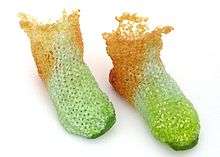
The first uses of glass were in beads and other small pieces of jewelry and decoration. Beads and jewelry are still among the most common uses of glass in art and can be worked without a furnace.
It later became fashionable to wear functional jewelry with glass elements, such as pocket watches and monocles.
Wearables and couture
Starting in the late 20th century, glass couture refers to the creation of exclusive custom-fitted clothing made from sculpted glass. These are made to order for the body of the wearer. They are partly or entirely made of glass with extreme attention to fit and flexibility. The result is usually delicate, and not intended for regular use.
Glass vessels
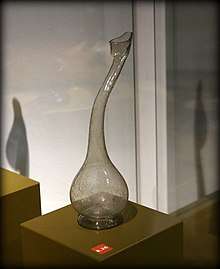
Some of the earliest and most practical works of glass art were glass vessels. Goblets and pitchers were popular as glassblowing developed as an art form. Many early methods of etching, painting, and forming glass were honed on these vessels. For instance, the millefiori technique dates back at least to Rome. More recently, lead glass or crystal glass were used to make vessels that rang like a bell when struck.
In the 20th century, mass-produced glass work including artistic glass vessels was sometimes known as factory glass.
Glass architecture
Stained glass windows
Starting in the Middle Ages, glass became more widely produced and used for windows in buildings. Stained glass became common for windows in cathedrals and grand civic buildings.
Glass facades and structural glass
The invention of plate glass and the Bessemer process allowed for glass to be used in larger segments, to support more structural loads, and to be produced at larger scales. A striking example of this was the Crystal Palace in 1851, one of the first buildings to use glass as a primary structural material.
In the 20th century, glass became used for tables and shelves, for internal walls, and even for floors.
Glass sculptures
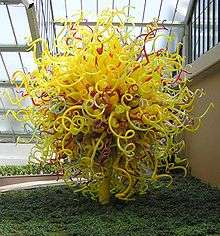
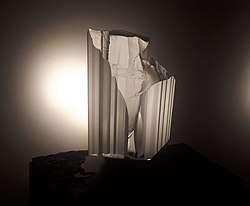
Some of the best known glass sculptures are statuesque or monumental works created by artists Livio Seguso, Karen LaMonte, and Stanislav Libenský and Jaroslava Brychtová. Another example is René Roubícek's "Object" 1960, a blown and hot-worked piece of 52.2 cm (20.6 in)[1] shown at the "Design in an Age of Adversity" exhibition at the Corning Museum of Glass in 2005.[2] A chiselled and bonded plate glass tower by Henry Richardson serves as the memorial to the Connecticut victims of the 9/11 terrorist attacks.[3]
Art glass and the studio glass movement
In the early 20th century, most glass production happened in factories. Even individual glassblowers making their own personalized designs would do their work in those large shared buildings. The idea of "art glass", small decorative works made of art, often with designs or objects inside, flourished. Pieces produced in small production runs, such as the lampwork figures of Stanislav Brychta, are generally called art glass.

By the 1970s, there were good designs for smaller furnaces, and in the United States, this gave rise to the "studio glass" movement of glassblowers who blew their glass outside of factories, often in their own studios. This coincided with a move towards smaller production runs of particular styles. This movement spread to other parts of the world as well.
Examples of 20th-century studio glass:
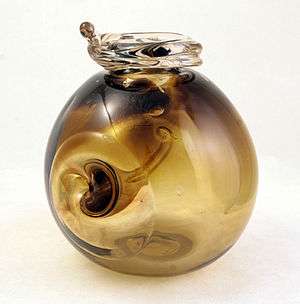 Vortex Vase
Vortex Vase Wind Song Glass
Wind Song Glass Merletto canework
Merletto canework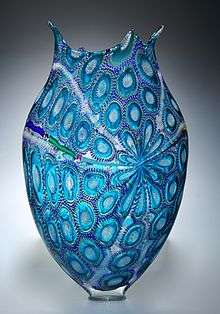 Murrine Foglio
Murrine Foglio Murrine detail
Murrine detail- Picking up murrine
Functional glass art in the 21st century
There has been a massive explosion in the underground art scene revolving around functional glass art. Many people agree that Bob Snodgrass was the first to popularize glass smoking vessels as well as fume (melting gold and silver to color glass), followed by his apprentices, including Jason Harris, founder of Jerome Baker Designs (company).[4] Harris led efforts to create the largest functional glass piece ever, called "Bongzilla."As Snodgrass traveled with the Grateful Dead he was able to share his techniques to many different people in many different communities before settling down in Oregon and creating the Eugene Glass School. As time went on, more and more artists got involved with pipe making and with the introduction of social media the market exploded. Top artists such as Quave, Banjo, and Sagan are able to bring in upwards of one hundred thousand dollars per piece with the market only expanding as the prohibition on marijuana slowly comes to an end.
Harris, under the Jerome Baker Designs brand, crafted the world’s largest bong in 2018, which is 24-feet high and weighs 800 pounds.[5]
Glass panels

Combining many of the above techniques, but focusing on art represented in the glass rather than its shape, glass panels or walls can reach tremendous sizes. These may be installed as walls or on top of walls, or hung from a ceiling. Large panels can be found as part of outdoor installation pieces or for interior use. Dedicated lighting is often part of the artwork.
Techniques used include stained glass, carving (wheel carving, engraving, or acid etching), frosting, enameling, and gilding (including Angel gilding). An artist may combine techniques through masking or silkscreening. Glass panels or walls may also be complemented by running water or dynamic lights.
Glass paperweights
The earliest glass art paperweights were produced as utilitarian objects in the mid 1800s in Europe. Modern artists have elevated the craft to fine art. Glass art paperweights, can incorporate several glass techniques but the most common techniques found are millefiori and lampwork—both techniques that had been around long before the advent of paperweights. In paperweights, the millefiori or sculptural lampwork elements are encapsulated in clear solid crystal creating a completely solid sculptural form.
In the mid 20th century there was a resurgence of interest in paperweight making and several artist sought to relearn the craft. In the US, Charles Kaziun started in 1940 to produce buttons, paperweights, inkwells and other bottles, using lampwork of elegant simplicity. In Scotland, the pioneering work of Paul Ysart from the 1930s onward preceded a new generation of artists such as William Manson, Peter McDougall, Peter Holmes and John Deacons. A further impetus to reviving interest in paperweights was the publication of Evangiline Bergstrom's book, Old Glass Paperweights, the first of a new genre.
A number of small studios appeared in the middle 20th century, particularly in the US. These may have several to some dozens of workers with various levels of skill cooperating to produce their own distinctive "line". Notable examples are Lundberg Studios, Orient and Flume, Correia Art Glass, St.Clair, Lotton, and Parabelle Glass.[6]
Starting in the late 1960s and early 70s, artists such as Francis Whittemore,[7] Paul Stankard,[8] his former assistant Jim D'Onofrio,[9] Chris Buzzini,[10] Delmo[11] and daughter Debbie Tarsitano,[12] Victor Trabucco[13] and sons, Gordon Smith,[14] Rick Ayotte[15] and his daughter Melissa, the father and son team of Bob and Ray Banford,[16] and Ken Rosenfeld[17] began breaking new ground and were able to produce fine paperweights rivaling anything produced in the classic period.
Techniques and processes
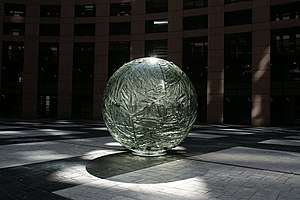
Several of the most common techniques for producing glass art include: blowing, kiln-casting, fusing, slumping, pâté-de-verre, flame-working, hot-sculpting and cold-working. Cold work includes traditional stained glass work as well as other methods of shaping glass at room temperature. Glass can also be cut with a diamond saw, or copper wheels embedded with abrasives and polished to give gleaming facets; the technique used in creating Waterford crystal.[18]
Fine paperweights were originally made by skilled workers in the glass factories in Europe and the United States during the classic period (1845-1870.) Since the late 1930s, a small number of very skilled artists have used this art form to express themselves, using mostly the classic techniques of millefiori and lampwork.[19]
Art is sometimes etched into glass via the use of acid, caustic, or abrasive substances. Traditionally this was done after the glass was blown or cast. In the 1920s a new mould-etch process was invented, in which art was etched directly into the mould so that each cast piece emerged from the mould with the image already on the surface of the glass. This reduced manufacturing costs and, combined with a wider use of colored glass, led to cheap glassware in the 1930s, which later became known as Depression glass.[20] As the types of acids used in this process are extremely hazardous, abrasive methods gained popularity.
Knitted and felted glass
Knitted glass is a technique developed in 2006 by artist Carol Milne, incorporating knitting, lost-wax casting, mold-making, and kiln-casting. It produces works that look knitted, though they are made entirely of glass.
Chinese artists Zhengcui Guo and Peng Yi premiered a technique of felted glass or "glelting", with positive critical reviews, at the 2015 Ha You Arts Festival.[21]
Glass printing
In 2015, the Mediated Matter group and Glass Lab at MIT produced a prototype 3D printer that could print with glass, through their G3DP project. This printer allowed creators to vary optical properties and thickness of their pieces. The first works that they printed were a series of artistic vessels, which were included in the Cooper Hewitt's Beauty exhibit in 2016.
Glass printing is theoretically possible at large and small physical scales and has the capacity for mass production. However, as of 2016 production still requires hand-tuning, and has mainly been used for one-off sculptures.
Pattern making
Methods to make patterns on glass include caneworking such as murrine, engraving, enameling, millefiori, flamework, and gilding.
Methods used to combine glass elements and work glass into final forms include lampworking.
Museums
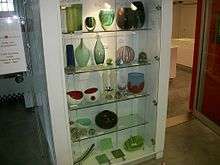
Historical collections of glass art can be found in general museums. Modern works of glass art can be seen in dedicated glass museums and museums of contemporary art. These include the Chrysler Museum in Norfolk, Virginia, the Museum of Glass in Tacoma, the Metropolitan Museum of Art, the Toledo Museum of Art, and Corning Museum of Glass, in Corning, NY, which houses the world's largest collection of glass art and history, with more than 45,000 objects in its collection.[22] The Museum of Fine Arts in Boston features a 42.5 feet (13.0 m) tall glass sculpture, Lime Green Icicle Tower, by Dale Chihuly.[23] In February 2000 the Smith Museum of Stained Glass Windows, located in Chicago's Navy Pier, opened as the first museum in America dedicated solely to stained glass windows. The museum features works by Louis Comfort Tiffany and John Lafarge, and is open daily free to the public.[24]
The Harvard Museum of Natural History has a collection of extremely detailed models of flowers made of painted glass. These were lampworked by Leopold Blaschka and his son Rudolph, who never revealed the method he used to make them. The Blaschka Glass Flowers are still an inspiration to glassblowers today.[25] The UK's National Glass Centre is located in the city of Sunderland, Tyne and Wear.
See also
| Wikimedia Commons has media related to Glass art. |
| Look up glass art in Wiktionary, the free dictionary. |
- Glassblowing
- Paperweight
- Factory glass, Art glass, and Studio glass
References
- "René Roubícek". The Corning Museum of Glass. The Corning Museum of Glass. Archived from the original on 11 June 2011. Retrieved 13 June 2014.
- "Czech Glass: Design in an Age of Adversity 1945-1980". The Corning Museum of Glass. The Corning Museum of Glass. Retrieved 13 June 2014.
- Pelland, Dave. "9/11 Memorial, Danbury". CTMonuments.net. Retrieved 27 February 2018.
- "A Cannabis Industry Icon Accepts Bitcoin". Retrieved 2020-05-27.
- "Renowned glassblowing artists will try to make 24-foot-high bong in Seattle". seattletimes.
- Flemming, M., p 38-42
- Dunlop, Paul H. p354
- Dunlop, Paul H. p315-317
- Dunlop, Paul H. p 123
- Dunlop, Paul H. p 267
- Dunlop, Paul H. p 328
- Dunlop, Paul H. p 326
- Dunlop, Paul H. p 335
- Dunlop, Paul H. p 304
- Dunlop, Paul H. p 267
- Dunlop, Paul H. p 44 & 45
- Dunlop, Paul H., p275
- "Waterford Crystal Visitors Centre". Retrieved 2007-10-19.
- Dunlop, Paul H. (2009). The Dictionary of Glass Paperweights. United States: Papier Presse. ISBN 978-0-9619547-5-8.
- "Depression Glass". Archived from the original on 2014-12-02. Retrieved 2007-10-19.
- "Beijing Design Week: Ha You Arts Festival". Beijing Design Week. Beijing Design Week. Retrieved 27 September 2015.
- "Corning Museum of Glass". Archived from the original on 2008-01-12. Retrieved 2007-10-14.
- "Lime Green Icicle Tower". Museum of Fine Arts. Retrieved October 26, 2014.
- Smith Museum of Stained Glass Windows Archived 2013-01-04 at Archive.today
- The Ware Collection of Blaschka Glass Models of Plants. The Harvard Museum of Natural History
a.jpg)